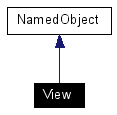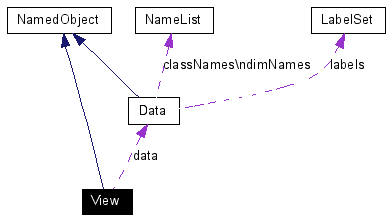
#include <View.h>
Inherits NamedObject.
Inheritance diagram for View:


Public Member Functions | |
| View (const char *name, Data *d) | |
| Creates an empty View object, associated with the passed Data set. | |
| View (const char *name, Data *d, int numToGen) | |
| Creates a View object associated with a particular data set, and generates random orderings of the full data set. | |
| void | addOrdering (OrderedSubset *os) |
| Adds a specified ordering to the view. | |
| void | genOrderings (int numToAdd) |
| Given a View object with at least a single ordering defined, will generate a specified number of permutations of the first orderings. | |
| int | getNumOrderings () |
| Accessor method. | |
| Data * | getData () |
| Accessor method. | |
| OrderedSubset * | getOrdering (int i) |
| Returns the specified ordering. | |
| void | list (ostream &s, int i) |
| Generates a space-separated list of the entries in a particular ordering of the View. | |
| void | hist (ostream &s, int i) |
| Generates a histogram of the classes in the View. | |
Learning in some classifiers, ARTMAP networks in particular, are sensitive to the order of presentation of samples. By storing multiple orderings of a subset of data within a View object, Classer can train multiple copies of a particular classifier, each with a different ordering of the subset. Orderings may be automatically generated within Classer, or passed from text files if specific orderings are desired. If an ordering is file-based, it is just a set of integer indices into the data set (i.e., line numbers, starting at 1), one per line.
|
||||||||||||
|
Creates an empty View object, associated with the passed Data set.
|
|
||||||||||||||||
|
Creates a View object associated with a particular data set, and generates random orderings of the full data set.
|
|
|
Adds a specified ordering to the view.
|
|
|
Given a View object with at least a single ordering defined, will generate a specified number of permutations of the first orderings. This lets the user control which subset of the data is used, but lets Classer handle permuting the set.
|
|
|
Accessor method.
|
|
|
Accessor method.
|
|
|
Returns the specified ordering.
|
|
||||||||||||
|
Generates a histogram of the classes in the View. This is also available for the data set as a whole, but this call can be used if the View is a subset smaller than the whole data set. Also, the call applies to a specified ordering of the View at a time.
|
|
||||||||||||
|
Generates a space-separated list of the entries in a particular ordering of the View.
|
 1.4.3
1.4.3